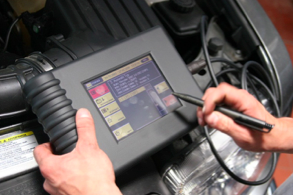Emission Time welcomes guest blogger Tim Miller, an avid car mechanic and founder of Obdadvisor.com. Tim offers useful tips for automotive maintenance using OBD scanners. Let’s get started!Â
 Computers are working their way into everything around us, including our cars. While this makes life a bit more complicated, it can also work to save you a lot of money when it comes to fixing your car. By picking up a cheap OBD-II scanner, you can diagnose, research, and repair many common car issues without spending a lot of money or visiting a mechanic.
Computers are working their way into everything around us, including our cars. While this makes life a bit more complicated, it can also work to save you a lot of money when it comes to fixing your car. By picking up a cheap OBD-II scanner, you can diagnose, research, and repair many common car issues without spending a lot of money or visiting a mechanic.
What’s OBD2? Does My Car Have It?
OBD-II (or OBD2) is a special format that your car uses to talk to electronic devices. OBD stands for “onboard diagnostics,” while the 2 means that this is the modern format that’s been used universally since 1996. Every car that’s been built since the introduction of OBD-II has a plug that can be hooked up to an OBD-II scanner. This allows the car’s sensors and computers to talk to your scanner and give you information about any car problems that you have.
What is An OBD2 Scanner?
On the surface, OBD-II scanners give you diagnostic information and error codes. Your car is equipped with lots of sensors that monitor key parts of the engine, drivetrain, and fuel system. When your car thinks it’s in need of maintenance, it’ll pull data from all of these sensors, turn on the check engine light, and begin outputting error codes through the OBD-II port. You can use a scanner to retrieve these codes, figure out what the problem is, and then reset your check engine light when you’ve fixed it.
Are OBD-II Scanners Just For Error Codes?
While it’s less universal, many newer cars also use their OBD-II port to govern hidden user settings. You can change how the lock button on your key dongle behaves, for example. Most cars only lock or unlock the driver’s side door on the first press. On several vehicles, you can use an OBD-II device to change that and make your dongle lock or unlock all of the doors immediately.
How Do I Use An OBD-II Scanner?
These days, the easiest way to use an OBD-II scanner is to hook it up to your phone. While standalone scanners exist, they’re much less convenient than Bluetooth or wireless models that connect to your phone without any cords at all.
Once you’ve found an OBD-II scanner you like, download a compatible app to your phone and plug it into your car’s OBD-II port. This port is usually located below the steering wheel on the driver’s side of your car, although the exact location varies. Once you turn your car on, the scanner will begin to work.
As soon as your car is on, navigate to your OBD2 app and connect to your scanner via Bluetooth or WiFi. From there, follow the on-screen interface to retrieve or reset error codes, view manufacturer-specific diagnostics, clear your check engine light, and more. It’s really that easy. You’ll be able to do everything you need from within the app!
What Do I Do With Error Codes?
Your OBD-II scanner gives you access to a lot of diagnostic information. Depending on the app you use and the error code you receive, however, it can be difficult to turn that information into a working solution that fixes your car.
The first thing you should do with any error code you get is Google it. By plugging as much information as you can into a search engine (the make, model, and year of your car, the error code, and even a short description of your problem), you’ll usually find information that’ll help you fix things. Most of the time, you’ll get the most information out of sites where other people have asked for help with similar problems. Browsing the solutions presented can give you a good idea about how to fix your car and how much time and money it will take.
Does Every OBD-II Scan Tool Read Codes From Every Car?
Your car outputs two types of trouble codes. “P0” codes are basic, universal issues, while “P1” codes are specific to certain makes and models of vehicles.
You don’t need to pair a scan tool to a specific vehicle, however. Any tool that reads P1 codes from any car will read P1 codes from your car. Be sure to get a scanner that gives you the ability to read all trouble codes, including manufacturer specific ones. Make sure your scanner can read diagnostic information and can reset codes as well.
What’s the Difference Between Trouble Codes and Diagnostics?
A trouble code is a recorded message from your car that can give you an idea of what’s going wrong. While these codes are a valuable tool for diagnosing car issues, they don’t present a complete picture. A lot of the time, they’re not specific enough for you to immediately figure out what your problem is.
Diagnostics are slightly different. Your car has dozens of sensors hooked up to important internal components. An OBD-II scanner can allow you to retrieve information from these sensors in real time. This helps you diagnose problems in detail as they occur. You can view fuel pressure, the temperatures of individual engine components, and much, much more. All of this information can help you pinpoint the cause and location of your car troubles in just a few minutes.
How Far Can You DIY?
Not every error code can be fixed easily in your own garage. Some car problems will require expensive tools, parts, and equipment to fix. When is it a good idea to fix the problem yourself and when should you involve a mechanic?
There’s no real limit to how far you can go on your own. If you’ve got experience working with cars, the right tools, and a couple of friends who can help, you can fix virtually any car issue on your own. On the other hand, if you’re less experienced, you don’t have tools, and you’re on your own, you should think carefully before you invest too much time, energy, or money into fixing your car yourself.
There are a couple important points to consider. First, your car is probably pretty important. If you plug in your scanner and the internet thinks that repairing your car will be difficult, you might want to call a professional immediately. You don’t want to accidentally make things worse or spend days working on a problem that would take a mechanic a few hours to fix. Instead, let a professional handle things so that you can have a working car as fast as possible.
Second, consider cost. If the solution you uncover seems like it’s expensive, call a mechanic and ask how much it would cost for them to fix your car. If it’s cheaper than buying the parts on your own, you should probably take the car in immediately.
Finally, safety should be a concern. If your fix requires that you do anything you’re not comfortable with (like using a jack or power tools you’re inexperienced with), you should proceed with caution. Contact a friend or family member with more experience or call a mechanic and get an estimate. You definitely don’t want to injure yourself by diving in too deep.
While this might sound like you can’t get very far on your own, in many cases it’s easy for people with no car expertise to fix their own problems. Purchasing an OBD-II scanner and researching your problem allows you to make an informed decision about how to proceed for just a few bucks. Plus, if you ever have another car problem, you’ll still have the scanner.
Beware of Cheap Diagnostic Tools
OBD-II scanners are always helpful, but they’re not all created equal. Some manufacturers make basic tools that only can read P0 error codes. These scanners can’t access more advanced P1 codes or read all of the diagnostic information that your car has to offer. Make sure that the scanner you purchase is fully functional and can read all codes and information that your car outputs.
OBD-II Scanners Can Save You Thousands Of Dollars
If you’ve got a car problem, it’s always a good idea to be informed. OBD-II scanners allow you to research your problem at home and find out more about it. In a lot of cases, you’ll be able to cheaply order parts off of the internet and perform an easy fix yourself that will solve all of your issues. Even if you can’t, you’ll be able to make a more informed decision at the mechanic and you’ll have a scanner you can use in the future to help with other issues in other cars. Over a few years, you can save hundreds or thousands of dollars by fixing small issues yourself and staying informed about your car’s maintenance issues.
For more tips on how to save money on automotive maintenance, by visiting homeviable.com.  Find out how to DIY cleaning and detailing your car’s interior.
About the author

I’m Tim Miller, an automotive mechanic and blogger from Denver, Colorado. I’m the founder of obdadvisor.com, an automotive blog about OBD2 scan tools. My fanpage is facebook.com/autozikcom.
I’ve had over 10 years experience in car repair and using OBD scanners.
Some of my review articles about car diagnostic tools can be found on my own website obdadvisor.com
